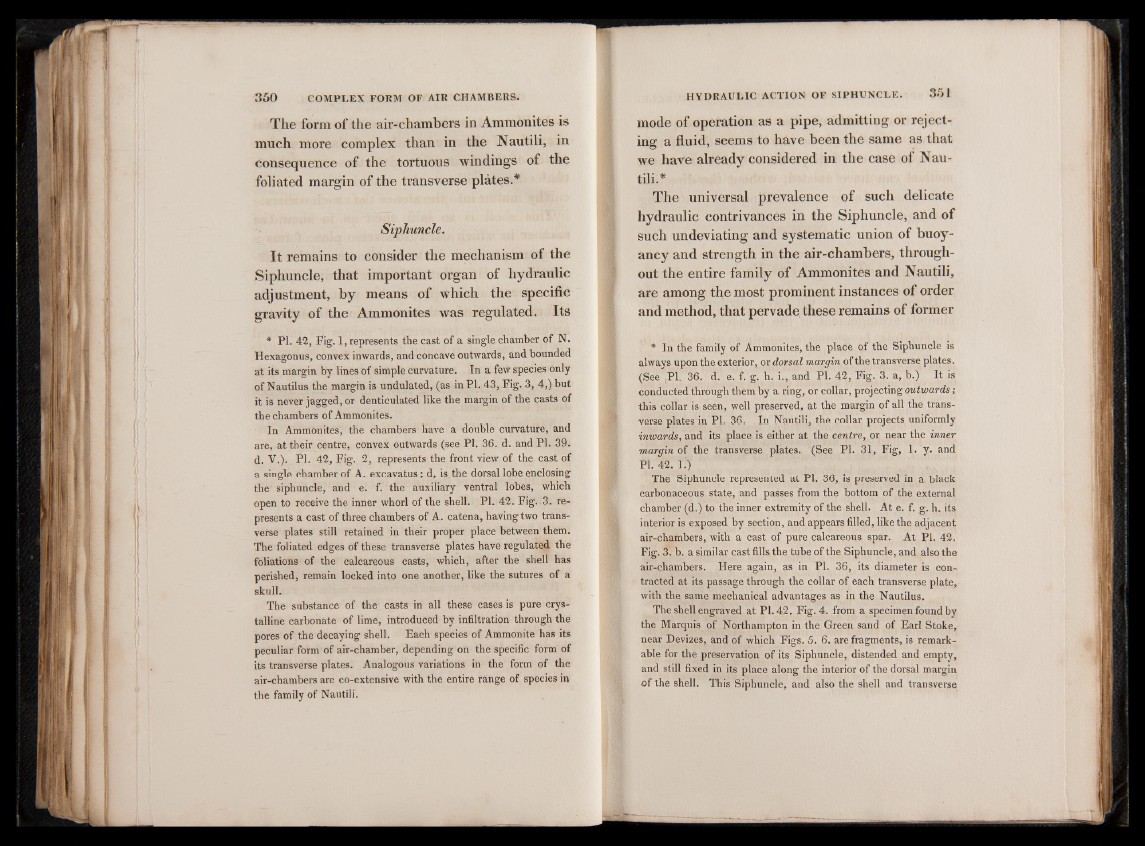
The form of the air-chambers in Ammonites is
much more complex than in the Nautili, in
consequence of the tortuous windings of the
foliated margin of the transverse plates.*
Siphuncle.
It remains to consider the mechanism of the
Siphuncle, that important organ of hydraulic
adjustment, by means of which the specific
gravity of the Ammonites was regulated. Its
* PI. 42, Fig. 1, represents the cast of a single chamber of N.
Hexagonus, convex inwards, and concave outwards, and bounded
at its margin by lines of simple curvature. In a few species only
of Nautilus the margin is undulated, (as in PI. 43, Fig. 3, 4,) but
it is never jagged, or denticulated like the margin of the casts of
the chambers of Ammonites.
In Ammonites, the chambers have a double curvature, and
are, at their centre, convex outwards (see PI. 36. d. and PI. 39.
d. V.). PI. 42, Fig. 2, represents the front view of the cast of
a single chamber of A. excavatus; d, is the dorsal lobe enclosing
the siphuncle, and e. f. the auxiliary ventral lobes, which
open to receive the inner whorl of the shell. PI. 42. Fig..'3. represents
a cast of three chambers of A. catena, having two transverse
plates still retained in their proper place between them.
The foliated edges of these transverse plates have regulated the
foliations of the calcareous casts, which, after the shell has
perished, remain locked into one another, like the sutures of a
skull.
The substance of the casts in all these cases is pure crystalline
carbonate of lime, introduced by infiltration through the
pores of the decaying shell. Each species of Ammonite has its
peculiar form of air-chamber, depending on the specific form of
its transverse plates. Analogous variations in the form of the
air-chambers are co-extensive with the entire range of species in
the family of Nautili.
mode of operation as a pipe, admitting or rejecting
a fluid, seems to have been the same as that
we have already considered in the case of Nautili.*
The universal prevalence of such delicate
hydraulic contrivances in the Siphuncle, and of
such undeviating and systematic union of buoyancy
and strength in the air-chambers, throughout
the entire family of Ammonites and Nautili,
are among the most prominent instances of order
and method, that pervade these remains of former
* In the family of Ammonites, the place of the Siphuncle is
always upon the exterior, or dorsal margin of the transverse plates.
(See ^1. 36. d. e. f. g. h. i., and PI. 42, Fig. 3. a, b.) It is
conducted through them by a ring, or collar, projecting outwards;
this collar is seen, well preserved, at the margin of all the transverse
plates in PI. 36. In Nautili, the collar projects uniformly
inwards, and its place is either at the centre, or near the inner
margin of the transverse plates. (See PI. 31, Fig, 1. y. and
PI. 42. l.j
The Siphuncle represented at PI. 36, is preserved in a black
carbonaceous state, and passes from the bottom of the external
chamber (d.) to the inner extremity of the shell. At e. f. g. h. its
interior is exposed by section, and appears filled, like the adjacent
air-chambers, with a cast of pure calcareous spar. At PI. 42.
Fig. 3. b. a similar cast fills the tube of the Siphuncle, and also the
air-chambers. Here again, as in PI. 36, its diameter is contracted
at its passage through the collar of each transverse plate,
with the same mechanical advantages as in the Nautilus.
The shell engraved at PI. 42. Fig. 4. from a specimen found by
the Marquis of Northampton in the Green sand of Earl Stoke,
near Devizes, and of which Figs. 5. 6. are fragments, is remarkable
for the preservation of its Siphuncle, distended and empty,
and still fixed in its place along the interior of the dorsal margin
o f the shell. This Siphuncle, and also the shell and transverse